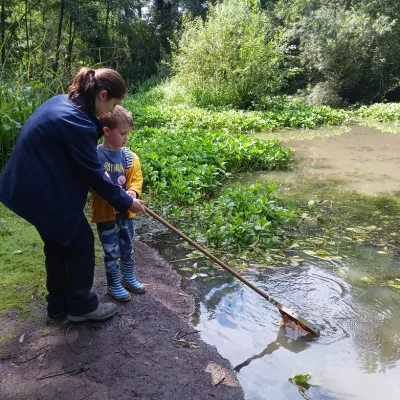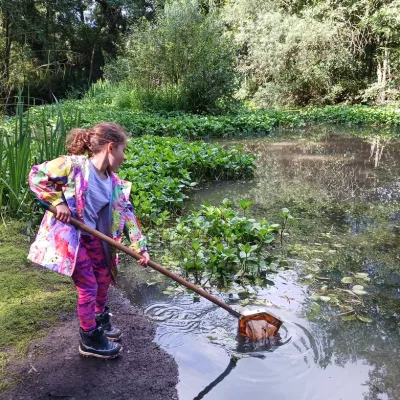Our Sevenoaks Wildlife Reserve is the perfect setting for this session of water-based exploration. Using our model river flume, learners will learn about the main features of a river and how the river Darent has formed.
Then, it’s time to don wellington boots and step into the river to investigate the physical aspects of the stream, including flow rate and river profile. Learners will also conduct a biological survey of the river, exploring organisms adapted to thrive in moving water. Combine this workshop with our Pond Dipping Detectives to contrast and compare the life found in static ponds and that found in flowing streams.
- Venue: available at Sevenoaks Wildlife Reserve
- Setting: Outdoors
- Time: 50 minutes – 90 minutes (depending on number of groups per visit)
National Curriculum Links
- identify and name a variety of common animals including fish, amphibians, reptiles, birds and mammals
- identify and name a variety of common animals that are carnivores, herbivores and omnivores
- explore and compare the differences between things that are living, dead, and things that have never been alive
- identify that most living things live in habitats to which they are suited and describe how different habitats provide for the basic needs of different kinds of animals and plants, and how they depend on each other
- identify and name a variety of plants and animals in their habitats, including microhabitats
- describe how animals obtain their food from plants and other animals, using the idea of a simple food chain, and identify and name different sources of food.
- notice that animals, including humans, have offspring which grow into adults
- find out about and describe the basic needs of animals, including humans, for survival (water, food and air)
- identify that animals, including humans, need the right types and amount of nutrition, and that they cannot make their own food; they get nutrition from what they eat
- recognise that living things can be grouped in a variety of ways
- explore and use classification keys to help group, identify and name a variety of living things in their local and wider environment
- recognise that environments can change and that this can sometimes pose dangers to living things
- construct and interpret a variety of food chains, identifying producers, predators and prey.
- describe the differences in the life cycles of a mammal, an amphibian, an insect and a bird
- describe the life process of reproduction in some plants and animals.
- describe how living things are classified into broad groups according to common observable characteristics and based on similarities and differences, including microorganisms, plants and animals
- give reasons for classifying plants and animals based on specific characteristics.
- identify how animals and plants are adapted to suit their environment in different ways and that adaptation may lead to evolution.



